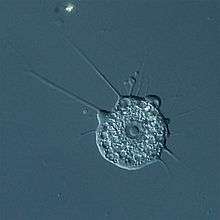Holomycota
| Holomycota | |
|---|---|
 | |
| Nuclearia | |
| Scientific classification | |
| Domain: | Eukarya |
| (unranked): | Opisthokonta |
| (unranked): | Holomycota Liu et al., 2009 |
| Groups[1] | |
| Synonyms | |
| |
Holomycota Liu et al. 2009 is a grouping that includes nucleariida and fungi.[3][4] [5]
Phylogeny
The cladogram depicts the fungi and their close relationship to other organisms, based on the work of Philippe Silar[6] and "The Mycota: A Comprehensive Treatise on Fungi as Experimental Systems for Basic and Applied Research".[7]
| |
| |||||||||||||||||||||||||||||||||||||||||||||||||||||||||||||||
| |
References
- ↑ Adl, S.M. et al. 2012. The revised classification of eukaryotes. Journal of Eukaryotic Microbiology, 59(5), 429-514
- ↑ Brown MW, Spiegel FW, Silberman JD (December 2009). "Phylogeny of the "forgotten" cellular slime mold, Fonticula alba, reveals a key evolutionary branch within Opisthokonta". Mol. Biol. Evol. 26 (12): 2699–709. doi:10.1093/molbev/msp185. PMID 19692665.
- ↑ Liu Y, Steenkamp ET, Brinkmann H, Forget L, Philippe H, Lang BF (2009). "Phylogenomic analyses predict sistergroup relationship of nucleariids and fungi and paraphyly of zygomycetes with significant support". BMC Evol. Biol. 9: 272. doi:10.1186/1471-2148-9-272. PMC 2789072
 . PMID 19939264.
. PMID 19939264. - ↑ Corsaro, D., Walochnik, J., Venditti, D., Steinmann, J., Müller, K. D., & Michel, R. (2014). Microsporidia-like parasites of amoebae belong to the early fungal lineage Rozellomycota. Parasitology research, 113(5), 1909-1918.
- ↑ Corsaro, D., Walochnik, J., Venditti, D., Müller, K. D., Hauröder, B., & Michel, R. (2014). Rediscovery of Nucleophaga amoebae, a novel member of the Rozellomycota. Parasitology research, 113(12), 4491-4498.
- ↑ Silar P (2016). "Protistes Eucaryotes: Origine, Evolution et Biologie des Microbes Eucaryotes". HAL: 462. ISBN 978-2-9555841-0-1.
- ↑ Esser K (2014). The Mycota VII A: Systematics and Evolution (2nd ed.). Springer. p. 461. ISBN 978-3-642-55317-2.
This article is issued from Wikipedia - version of the 11/7/2016. The text is available under the Creative Commons Attribution/Share Alike but additional terms may apply for the media files.